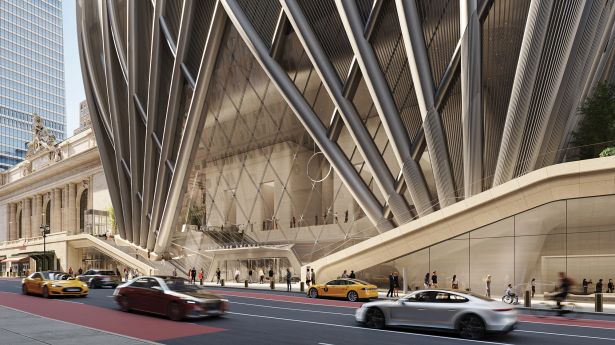Anchor Tenants Are Disrupting Manhattan’s Office Market — in a Good Way
Top corporate names are signing for new Class A space years in advance, freeing up much-needed square footage while at the same time boosting rents
By Isabelle Durso October 28, 2025 8:30 am
reprints
It looks like anchor tenants are the shiny new toy in New York City’s office market.
A handful of high-profile developers are moving forward with huge premier office projects in Manhattan (mostly in Midtown), and they’re all negotiating with the same species of anchor tenants. Some of them already have deals signed with these tenants — mostly financial services, tech and law firms — even though the projects won’t be completed for at least another few years.
For example, in April, financial advisory firm Deloitte agreed to lease 800,000 square feet at 70 Hudson Yards, a more than 60-story, 1.1 million-square-foot office skyscraper being developed by Related Companies and Oxford Properties on Manhattan’s West Side. Deloitte will leave its current headquarters at 30 Rockefeller Plaza for the new building, which isn’t set to be completed until late 2028.
Then, in September, global law firm Simpson Thacher & Bartlett agreed to take roughly 700,000 square feet at Extell Development’s 570 Fifth Avenue development, which is set to become a 29-story office and retail building anchored on the retail side by Ikea. That project is also expected to top out by the end of 2028.
Most recently, BXP reached a tentative deal in October with insurance and investment giant C.V. Starr to lease roughly 30 percent, or 275,000 square feet, of its $2 billion 343 Madison Avenue office development, which should be completed by 2029.
The sudden uptick in anchor tenant signings blends with other trends spurring once skittish developers toward their finish lines. Those trends include sterner return-to-office mandates and a highly active office market boasting healthy leasing overall.
“The spark was because the financial service sector, and all of the law firms, consulting firms and accounting firms that are clustered around the financial service sector, have been in a serious organic growth and consolidation mode,” Mary Ann Tighe, CEO of CBRE’s New York tri-state region, told Commercial Observer.
“This growth sector in New York believes deeply that the in-office experience is essential,” Tighe added. “And, even further than that, they realize that the quality of real estate is a recruiting tool, and so they’re looking to upgrade their environment. They’re looking to bring people together. And that’s an equation that equals a newer building and a big block of space.”

Newer buildings and big blocks of space are certainly on the way. Besides the ones listed above, there’s BXP’s 3 Hudson Boulevard, RXR and TF Cornerstone’s 175 Park Avenue, Related’s 625 Madison Avenue, Tishman Speyer’s 99 Hudson Boulevard, Silverstein Properties’ 2 World Trade Center (where American Express is rumored to be the anchor tenant), and Vornado Realty Trust and Rudin’s 350 Park Avenue for Citadel’s headquarters, to name a few. J.P. Morgan Chase’s new owner-occupied, 2.5 million-square-foot HQ at 270 Park Avenue also just opened, with a potential de facto J.P. Morgan neighborhood on the way too.
By the sound of it, things are going swimmingly for developers and tenants alike. So what’s the problem? Well, despite millions of square feet coming onto the office market with these new projects, there still isn’t enough available — and suitable — Class A offices in Manhattan, in part because these larger anchors are already claiming the space.
Manhattan’s overall office inventory dropped from 466.1 million square feet in the second quarter of 2025 to 449.4 million square feet during the third quarter, according to a recent report from Savills.
That’s 16.7 million square feet of office inventory deleted in just one quarter. The culprit could likely be office-to-residential conversions, as 4.1 million square feet of conversions had already commenced in 2025 as of August and another 8.8 million square feet are on the way, according to a recent report from Cushman & Wakefield. That’s compared to the total 3.3 million square feet of conversion starts recorded in 2024.
However, not all of that 16.7 million square feet was vacant.
“They had office occupiers in them, and so those office occupiers are now forced to look for new space, and they’re actually looking more into the middle of the market for choices,” said Peter Riguardi, chairman and president of JLL’s New York region.
“Right at the same time, at the top of the market, there’s not a lot of prime new choices,” Riguardi said. “Some occupiers who wanted to be in Hudson Yards or new buildings are being pushed into the middle. So it’s affecting the whole ecosystem of office supply.”
What happens next is a cycle: New real estate comes on the market, that space gets leased up almost immediately by top occupiers, and the rest of the market’s tenants are left to fill in the gaps. Not to mention, new tenants entering Manhattan will have a pretty hard time finding any leftover space.
“What we are witnessing in the market is akin to musical chairs among large anchor tenants,” said Paul Glickman, vice chairman and international director in JLL’s New York office. “When the music stops, we are very likely not going to have enough suitable sites to accommodate the demand.”
In fact, Manhattan’s overall office vacancy, while not yet at pre-pandemic numbers, hit a five-year low with a rate of 14.8 percent during the third quarter of 2025, according to a report from JLL. The drop was mainly due to 35 large-block deals signed during the first nine months of the year, including 11 in the third quarter.
In addition, the increased competition for high-quality office space has driven rents to record highs, with average rents in Midtown increasing by 2 percent from the second quarter to $85.44 per square foot in the third quarter, according to JLL. Manhattan’s trophy office stock — which has seen a 38 percent decrease in vacancy since the third quarter of 2024, down to a mere 7.6 percent — also saw rents increase by 3 percent quarter-
over-quarter to $132.24 per square foot, JLL found.
(Most of Manhattan’s new office developments will have asking rents north of $200 per square foot, according to sources.)
As a result of the competition, most trophy office buildings in popular areas such as Bryant Park and along Park Avenue are nearly fully leased, with vacancy rates around 1 percent and rents in the hundreds of dollars per square foot. At the Seagram Building, for example, rents are around $285 per square foot. And, at One Vanderbilt, an eye-catching office tower that opened toward the start of the pandemic, there’s no space left.
“It’s a very interesting paradigm in the marketplace,” Glickman said. “2024 and 2025 have been incredibly strong markets with enormous leasing velocity and absorption, particularly at the top of the market. Tenants are back, they’ve returned to work stronger than expected, and they are growing.
“But if you’re a big corporate occupier and you want to keep up with the Joneses and find a standout headquarters for recruitment — like so many tenants did with Manhattan West, Hudson Yards and One Vanderbilt — you’re not going to easily find new product,” Glickman added.
And, even if they wanted to, smaller office tenants won’t be able to keep up — in fact, they’re already being priced out.
So far in 2025, 101 lease transactions with rents between $100 and $149 per square foot have been signed, as well as 26 transactions with rents between $150 and $199 per foot, and 16 transactions with rents over $200 per foot, according to data from CBRE. That total of 143 transactions covers 19.1 percent of the overall office leasing velocity in terms of square footage recorded so far in 2025, and 15.8 percent of the overall velocity in terms of transaction count.
Trophy and Class A properties have also captured 81.1 percent of Manhattan leasing activity so far in 2025, compared to 69.8 percent in 2023, according to a report from Avison Young.
All that makes the search for lower rents and quality space extremely difficult, especially as large office tenants continue to soak up trophy space and drive rents to levels that smaller tenants find almost unbearable. Plus, they’re leaving little to no space for smaller tenants to expand or even sign new leases.
“There’s not enough of the right kind of space,” said William Elder, executive vice president of RXR and managing director of the firm’s New York City division. “There’s a war for space going on in some of the prime locations. You’ve got buildings being taken out of the inventory for conversion into residential. There’s a pipeline of tenants entering the market that is as robust as ever.”
As a result, the limited supply of new construction is “forcing tenants to compete for space against one another,” according to Steven Durels, executive vice president and director of leasing at SL Green Realty, whose portfolio includes One Vanderbilt.
“You’re seeing a rapid increase in rents,” Durels added. “That’s what’s bringing our market back to a very healthy place, while at the same time flushing out the bottom part of the market.”
It’s not unfamiliar territory, either. Other eras have brought a lot of new prime space while disposing of aging stock.
“It’s like the three baby bears: Mama Bear, Papa Bear, Baby Bear. None of the porridges seem to be the right temperature,” Riguardi said. “We never quite have enough space at times, and then at times we have too much space.”
On the bright side for tenants, new office developments in Midtown are slowly helping to bridge the gap. The developments are gradually but surely giving existing office assets in Midtown “a little bit of breathing room” as anchor tenants move to new space, allowing those assets to “serve existing clients better,” according to Hilary Spann, executive vice president of BXP.
Anchor tenants are indeed shifting their gaze to new stock as developers vie for their attention. In fact, developers that have already secured an anchor tenant lease are way ahead in the game, as those pre-leasing deals are “the solution” for some properties to move forward with construction financing, according to CBRE’s Tighe.
“What would be optimal for most developers is if they have the rent start as close to completion as possible,” Tighe said. “The tenant is always the solution, and, in the case of new construction in New York, it’s always the solution.”
And, when it comes to actually getting these anchor tenant deals signed, it’s pretty much an “exact science,” according to Riguardi, who has completed several major leases for anchor tenants during his 23-year career at JLL.
“The developer is constrained by lending requirements, and the occupier is confined by what they want for flexibility in their occupancy and what they want for branding and identity,” Riguardi said. “And those two needs need to match up, or you can’t have a deal.”
Anchor tenant leases — which often have a minimum length of 15 to 20 years in order for developers to secure financing — also all require the same basic elements, Tighe added.
“With anchor leases, you’re solving for three things,” Tighe said. “You’re solving for scale. You’re solving for the creditworthiness of the tenant, because that’s what you’re taking to the bank to get your loan. And the third thing you’re solving for is a tenant who can be in the base of the building. You’re not doing a 2 million-square-foot building and putting the anchor at the top, because what year is the top coming?
“And maybe here’s a fourth component — you need a business that can look five years in advance on their real estate,” Tighe added. “You’re signing for something that doesn’t exist, and you have to believe that your business is going not only to be in existence, but is going to have the same physical requirements that you envision today, five years hence. So it’s a very small universe of people who can anchor.”

Spann said that that’s exactly the sort of tenant BXP negotiates with.
“Because we have premier assets, we tend to have businesses that do long-range planning, and have a five-year or 10-year strategy,” Spann said. “They are focused on their business strategy, and they are taking down space in accordance with the needs of that strategy. So real estate is really an input to the business, and for most businesses that business strategy is actually more important than the real estate strategy.”
But trust also goes both ways. Reputation is “huge” for developers looking to secure anchor tenants and promise them high-quality, amenity-filled spaces, Tighe said.
“Breaking into the universe of skyscraper development requires complete faith on the part of the anchor that the capital’s there and that [a developer] knows how to build,” Tighe said. “You should not be learning on the job. You better have built somewhere else, and you certainly shouldn’t be starting the first time in New York. The sponsor has to be able to demonstrate a capacity not only to capitalize, but to construct.”
BXP is certainly aware of that. The real estate investment trust’s 1.8 million-square-foot development at 3 Hudson Boulevard will likely require an anchor tenant in the range of 600,000 to 700,000 square feet in order to secure construction financing, Spann said.
It managed fine at 343 Madison. BXP is in the process of turning the former Metropolitan Transportation Authority HQ into a 46-story, 930,000-square-foot tower with offices, dining spaces, terraces and a seemingly endless amount of amenities. The first phase of construction on that project will be completed in June 2026, while the second and final phase is set to be done in 2029, Spann said.
Because 343 Madison is being built on a smaller scale than 3 Hudson Boulevard, BXP is funding construction off its balance sheet since it’s easier to fund a smaller development in the interim, Spann said. In addition, BXP has no joint venture partner at 343 Madison, allowing it to control the entire project. That made C.V. Starr’s anchor lease the icing on the cake.
“If you have the capital available to fund, you don’t have to have a pre-lease tenant,” Spann said. “But, for most developers in the market, if you require equity capital or debt capital, those capital providers are going to want to see some level of pre-
leasing just to get comfortable with the fact that it’s something that will be desirable at the end of development, and that they’ll make a return on their investment.”
Across the street from BXP’s project, SL Green is betting on that (no casino pun intended). This month, SL Green closed on its deal to buy the former Brooks Brothers building at 346 Madison Avenue — as well as the adjacent 11 East 44th Street — for a total of $160 million, with plans to build a 41-story office building.
SL Green is beginning the process of soliciting architectural designs for the roughly 800,000-square-foot project and plans to deliver the building to tenants in late 2030, according to Durels. He added that SL Green will likely build the project on spec without having a significant anchor tenant at the outset, similar to its highly successful One Vanderbilt development.
“This one by comparison to One Vanderbilt should be very straightforward,” Durels said. “The entire site sits on bedrock, while One Vanderbilt was up against the shuttle subway on one side of the building, and at the north corner of the building had Metro-North tracks that cut across the corner of the site. So it was a much more complicated site, whereas the Brooks Brothers site is very straightforward.”
RXR and TF Cornerstone have an equally optimistic outlook for their development near Grand Central Terminal. The two developers are replacing the Grand Hyatt Hotel at 175 Park Avenue with a dramatic 1,600-foot office-and-hotel tower known as 175 Park — a project that Tighe calls the “most ambitious skyscraper” being built in the city due to its sheer scale and complexity.
Some of those complex details include demolishing the 26-story Hyatt hotel down to the ground floor in order to prevent major disruptions to train activity in Grand Central, as well as removing several large structural columns that block access to the subway station.
RXR and TF Cornerstone also plan to build a new public train hall and a 12,000-square-foot passageway linking to Long Island Rail Road train platforms. Elder said RXR plans to break ground next year and is “confident” it will have an anchor tenant before construction starts.
To put it simply, there’s a lot of activity going on in the New York City office market now. And, despite new developments causing a so-called “musical chairs” effect for today’s tenants, it seems as if the city will mostly reap the benefits rather than the drawbacks.
“It’s an exciting time for New York with these projects going on and the amount of tenant activity,” Elder said. “It’s been a tough road for the last few years, but now New York is back. It’s exciting.”
Isabelle Durso can be reached at idurso@commercialobserver.com.


